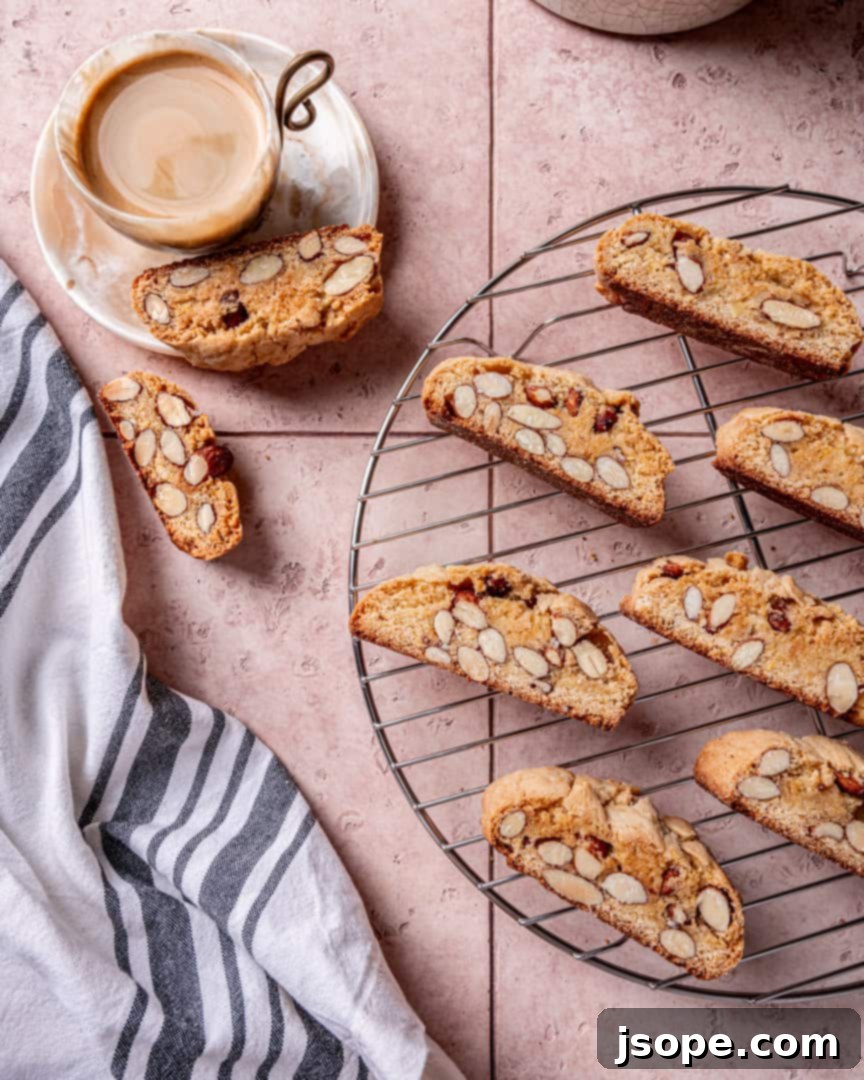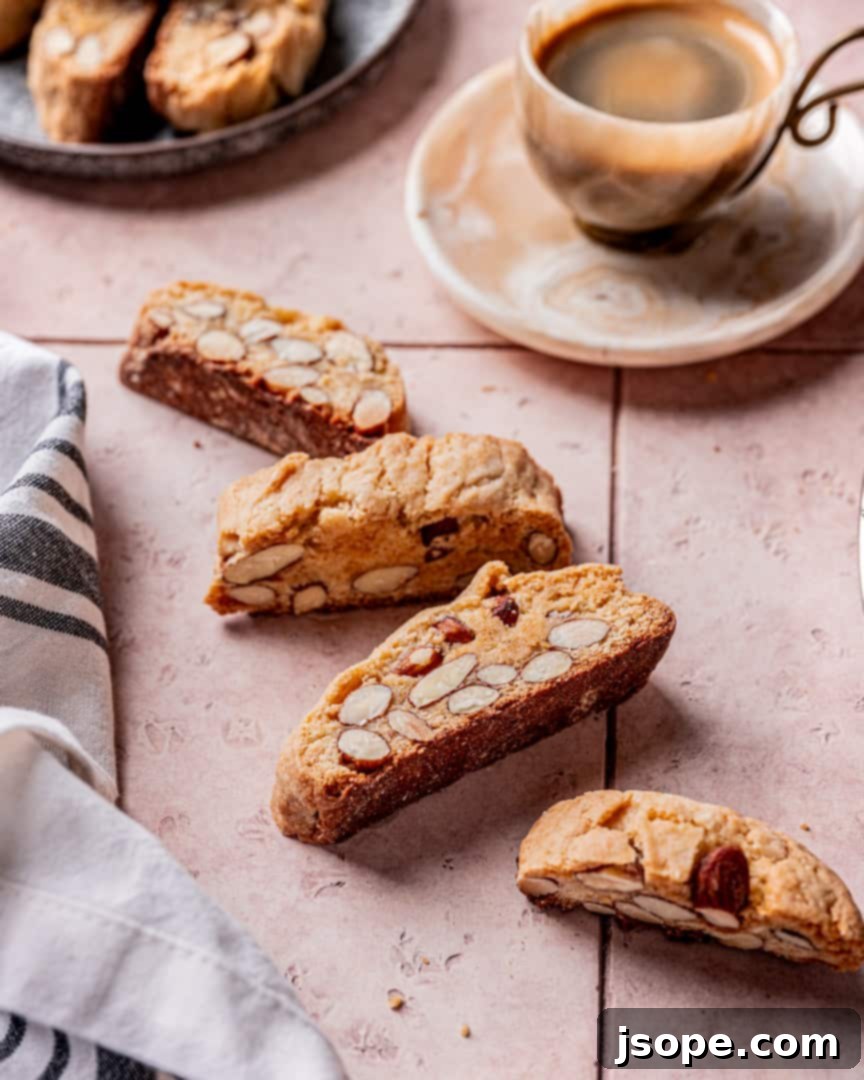Who can resist the delightful crunch and rich flavor of a perfectly baked biscotti? These iconic Italian cookies are a true culinary treasure, offering a versatile treat that fits any moment of your day. Whether you enjoy them alongside your robust morning coffee, as a sophisticated accompaniment to afternoon tea, or as a decadent dessert dipped in sweet Italian Vin Santo wine or a luscious chocolate sauce, biscotti are simply irresistible. In Italy, these beloved crunchy delights are traditionally known as cantucci, particularly those originating from the heart of Tuscany. However, in many parts of the world, especially the United States, they are broadly referred to as biscotti.
The beauty of biscotti lies not only in their exquisite taste but also in their remarkable simplicity. Crafting these delightful cookies at home is surprisingly straightforward, requiring just a handful of staple ingredients that you likely already have in your pantry or can easily acquire from your local grocery store. Our family has been perfecting cantucci for generations, and today, we are thrilled to share our cherished version of Homemade Almond Biscotti (Italian Cantucci) with you. This particular Italian Biscotti recipe incorporates a few thoughtful ingredients that elevate its flavor and texture, making it our absolute favorite – and we are confident it will quickly become yours too!

Understanding Cantucci: A True Italian Delight
To truly appreciate these remarkable cookies, it’s helpful to understand the terminology. The term “biscotti” itself is derived from Latin, meaning “twice cooked” or “twice baked.” Historically, this method of cooking was used to dry out baked goods, making them highly durable and ideal for travel or long-term storage, a necessity for Roman legions and sailors alike. This practice gave birth to various forms of twice-baked goods, from bread to biscuits. Therefore, in its broadest sense, “biscotti” can refer to any cookie or bread that undergoes this unique baking process.
However, when speaking of the specific almond-studded, dry, and hard cookie popular worldwide, the correct Italian term is cantucci. These iconic biscuits hail from the picturesque region of Tuscany, where they have been a culinary staple for centuries. Traditionally, these classic Italian cookies are generously studded with whole almonds, which contribute to their characteristic crunch and nutty flavor. While the almond version remains the most authentic and popular, modern variations now include a wide array of nuts, dried fruits, and flavorings.
Throughout Tuscany, you’ll find cantucci gracing dessert menus in trattorias and ristorantes, most frequently served alongside Vin Santo. This amber-colored, sweet dessert wine, also a specialty of Tuscany, creates a magical pairing. The traditional ritual involves dipping the hard cantucci into the Vin Santo, allowing the cookie to soften slightly and absorb the wine’s sweet, aromatic notes. This simple act transforms the cookie into a tender, flavorful bite, creating an unforgettable dessert experience. We enthusiastically recommend trying this pairing when you make our almond biscotti recipe; it’s a truly authentic taste of Italy that you won’t want to miss!
Fun Fact: In Italian grammar, words ending in “i” are often plural. So, the singular form of biscotti is biscotto, and for cantucci, it’s cantuccio. There’s no need to add an “s” to the end of these Italian plurals, unlike in English!
Whether you call these delightful almond cookies cantucci or biscotti, one thing remains undeniably true: they are incredibly delicious and utterly satisfying.
If you’re eager to explore more classic Italian desserts, be sure to check out our Homemade Lemon Cream Gelato – a superb treat that also pairs wonderfully with a piece of homemade biscotti!
Why Choose Homemade Almond Biscotti?
While store-bought biscotti offer convenience, making them at home unlocks a world of flavor, freshness, and satisfaction that simply can’t be matched. Homemade almond biscotti allows you to control the quality of ingredients, customize the flavor profile to your liking, and enjoy the unparalleled aroma of freshly baked goods filling your kitchen. The process, while involving two baking stages, is straightforward and immensely rewarding. Plus, there’s a unique sense of accomplishment and pride that comes with sharing a batch of your own, perfectly crunchy, twice-baked Italian cookies.
Our recipe emphasizes a balance of traditional methods and carefully selected ingredients to create biscotti that are not too sweet, allowing the natural nutty flavor of the almonds and the bright zest of orange to shine through. This harmonious blend makes them perfect for dipping, as they absorb other flavors beautifully without being overpowered. The crisp, firm texture achieved through the double-baking process also means they hold up exceptionally well, making them ideal for gifting or enjoying over several weeks.
The Simple Ingredients for Perfect Biscotti
One of the many reasons to love this recipe is its reliance on just a few simple, wholesome ingredients. These twice-baked Italian cookies are a testament to how humble components can come together to create something extraordinary.
- Roasted Almonds: These are the heart and soul of traditional cantucci. We recommend using whole, unblanched almonds, preferably lightly roasted or unsalted. The roasting process deepens their nutty flavor, which is crucial for the overall taste profile of the biscotti. Their robust presence provides that satisfying crunch and authentic Italian character.
- Flour: While all-purpose flour works perfectly well and is readily available, for an authentic touch, consider using Tipo “00” flour if you can find it. Tipo “00” is a finely milled Italian flour that can contribute to a slightly lighter texture, though the difference is subtle in a dry cookie like biscotti.
- Sugar: Our recipe calls for a modest amount of white granulated sugar. Biscotti are not meant to be overly sweet; their charm lies in a more nuanced sweetness that allows other flavors to come forward, especially when dipped in sweet wines or coffee.
- Orange Zest: This ingredient is a game-changer! Traditional in many biscotti recipes, orange zest introduces a bright, fragrant citrus note that perfectly complements the almonds. It adds a layer of sophistication and freshness that makes these cookies truly stand out.
- Baking Powder: A small amount of baking powder provides just the right amount of leavening, helping the dough to rise slightly during the first bake and contributing to the biscotti’s characteristic light yet sturdy crumb.
- Kosher Salt: A pinch of kosher salt is essential. It doesn’t just add saltiness; it balances the sweetness, enhances the almond and orange flavors, and brings all the ingredients into harmony, making the overall taste more vibrant.
- Egg: The egg acts as a crucial binder, holding the dough together and contributing to its structure. It also helps in achieving a lighter texture, ensuring the biscotti aren’t overly dense.
- Honey: Beyond just sweetness, honey adds a unique depth of flavor and a subtle richness that granulated sugar alone cannot provide. Its natural sugars also contribute to a beautiful golden-brown color during baking.
- Vanilla Extract: A classic pairing with almonds, vanilla extract infuses the biscotti with a warm, comforting aroma and a delicate sweetness that enhances the nuttiness without overpowering it.
- Unsalted Butter: We opt for unsalted butter to maintain precise control over the salt content in the recipe. The butter should be very soft, almost melted and cooled (but not hot), to ensure it incorporates smoothly into the dough. Butter significantly enriches the flavor and contributes to a more tender-crisp texture.
For exact quantities, please refer to the comprehensive recipe card below.

Versatile Substitutions for Your Biscotti
While our recipe is perfected for classic almond biscotti, don’t hesitate to experiment with these simple substitutions to tailor the flavors to your preference or what you have on hand.
- Orange Zest: If fresh oranges aren’t available, or you prefer a different citrus note, lemon zest is an excellent substitute, yielding equally tremendous results. Its bright, tangy profile complements almonds beautifully. You could even try lime or grapefruit zest for a more adventurous twist, just ensure the citrus flavor enhances, rather than dominates, the delicate almond notes.
- Vanilla Extract: While we adore the warmth of vanilla, a fantastic alternative is almond extract. Replacing vanilla with almond extract will intensify the almond flavor, creating a truly almond-forward version of biscotti that nut lovers will adore. Use it sparingly, as almond extract can be quite potent.
- Unsalted Butter: If only salted butter is available, you can use it, but be sure to omit the kosher salt specified in the recipe to avoid an overly salty cookie. For a complete butter substitute, vegetable shortening can be used in the same quantity. Keep in mind that butter offers a richer flavor profile than shortening, but shortening will still provide the necessary fat content for texture.
Crafting Homemade Almond Biscotti (Italian Cantucci): A Step-by-Step Guide
Making traditional Italian Cantucci or Biscotti at home is a rewarding process that’s far simpler than you might imagine. Here’s a breakdown of the equipment you’ll need and the detailed steps to follow:
Essential Equipment for Biscotti Baking
- A Large Mixing Bowl: Crucial for combining all your ingredients without making a mess, allowing ample space to mix the dough thoroughly.
- A Cutting Board or Clean Work Surface: Essential for turning out the dough and forming it into uniform logs (or “loaves”) before the first bake.
- A Sheet Tray or Cookie Sheet: Large enough to accommodate both biscotti logs, ensuring they have enough space to spread slightly without touching.
- Parchment Paper: While not strictly mandatory, lining your baking sheet with parchment paper is highly recommended. It prevents sticking, makes cleanup a breeze, and ensures easy transfer of the delicate logs. Pre-cut parchment sheets are a great time-saver.
- Sharp Knife (preferably serrated): For slicing the partially baked logs into individual biscotti. A very sharp knife, especially a serrated bread knife, will help prevent crumbling.
- Wire Rack: For cooling the biscotti after their second bake, ensuring even cooling and crispness on all sides.
Detailed Step-by-Step Instructions
Follow these instructions carefully to create perfectly crispy and flavorful almond biscotti:
Step 1: Combine the Dry Ingredients
In your large mixing bowl, combine the flour, granulated sugar, baking powder, and kosher salt. Use a spatula or whisk to mix these dry ingredients thoroughly until they are well combined and uniform. This ensures that the leavening agent and salt are evenly distributed throughout the dough.
Step 2: Incorporate the Wet Ingredients and Almonds
Create a small well in the center of your dry ingredient mixture. Into this well, add the orange zest, large egg, honey, and vanilla extract. Begin by stirring with a fork from the center, gradually incorporating the dry ingredients from the sides until a shaggy dough begins to form. Switch to a spatula and continue mixing until all ingredients are thoroughly combined and no dry pockets of flour remain. Finally, fold in the roasted almonds until they are evenly distributed throughout the dough. The dough will be firm and slightly sticky.
Step 3: Shape the Dough Logs for the First Bake
Turn the prepared dough out onto a clean, lightly floured work surface. Divide the dough roughly in half. With your hands, gently form each half into a cylindrical log or “loaf.” Aim for logs that are approximately 1″ to 1.5″ thick and just under 2″ wide. Transfer these shaped logs to your parchment-lined baking tray, ensuring they are placed far enough apart to allow for some spreading during baking without touching. Gently flatten the logs to achieve the desired dimensions. The shape doesn’t have to be perfect, as minor imperfections add to the rustic charm.
Step 4: The Initial Bake
Preheat your oven to 350°F (175°C). Once preheated, place the baking tray with your biscotti logs into the oven. Bake for 20-22 minutes, or until the logs are lightly golden brown and firm to the touch. The internal temperature of the logs should reach about 200°F (93°C). Once baked, remove the tray from the oven and carefully transfer the logs to a wire rack to cool slightly. Reduce your oven temperature to 300°F (150°C) for the second bake.
Step 5: Cool and Slice the Biscotti
Allow the baked logs to cool on the wire rack for about 10 minutes. They will still be warm but firm enough to handle. Gently transfer the warm logs to a cutting board. Using a very sharp, preferably serrated knife, slice the logs into individual biscotti pieces, approximately ¾” wide. Use a gentle sawing motion to prevent crumbling. Replace the used parchment paper on your sheet tray with a fresh piece, then arrange the sliced cantucci cut-side down onto the tray. This ensures even browning during the second bake.
Step 6: The Second Bake for Ultimate Crispness
Return the tray with the sliced biscotti to the preheated 300°F (150°C) oven. Bake for an additional 11-12 minutes, or until the biscotti are golden brown and thoroughly crisp. This second bake is crucial for achieving their signature dry, crunchy texture and extending their shelf life. Once done, remove the tray from the oven and immediately transfer the biscotti to a wire rack to cool completely. The residual heat will continue to crisp them as they cool. Enjoy your perfectly crunchy homemade almond biscotti!

Creative Variations to Personalize Your Biscotti
One of the joys of baking biscotti is the endless possibilities for customization. While the classic almond and orange zest combination is divine, here are some inspiring ideas to experiment with and make this recipe truly your own:
- Experiment with Different Nuts: Although almonds are traditional, many other nuts beautifully complement the biscotti base. Consider pistachios for a vibrant color and unique flavor, pecans for a buttery richness, walnuts for earthy notes, macadamia nuts for a tropical touch, or hazelnuts for a classic Italian pairing (especially good with chocolate!). Pumpkin seeds or sunflower seeds can also offer a delightful crunchy texture and flavor.
- Switch Up the Citrus Zest: Lemon zest is a brilliant alternative to orange, offering a brighter, tangier profile that is equally delicious. For more adventurous palates, explore bergamot, tangerine, or even a hint of lime zest. Remember to use citrus that complements the almond base without overpowering it, aiming for a subtle, aromatic addition.
- Incorporate Dried Fruit: Dried fruits can add wonderful bursts of sweetness and chewiness to your cantucci. Dried cranberries, raisins (golden or dark), chopped apricots, or blueberries are all excellent choices. Be mindful of quantities; too much fruit can introduce excess moisture to the dough, affecting the crispness. Aim for about ¾ cup (100g) of dried fruit to maintain the ideal texture.
- Indulge with a Chocolate Dip: For a truly decadent treat, consider dipping or drizzling half of your cooled biscotti in melted chocolate. Dark chocolate offers a sophisticated bitterness, milk chocolate provides a creamy sweetness, and white chocolate can add a smooth, vanilla-like finish. Ensure the chocolate hardens completely for easy handling and a delightful contrast in textures.
- Enhance with Additional Flavorings: Elevate the spice profile by adding a pinch of cinnamon or a touch of ground anise for a more traditional Italian flair, reminiscent of some regional biscotti varieties. For an adult twist, a tablespoon of almond liqueur (Amaretto) or hazelnut liqueur (Frangelico) can be added to the wet ingredients, deepening the flavor with an aromatic warmth.
Storing Your Homemade Almond Biscotti
Proper storage is key to maintaining the crispness and extending the shelf life of your homemade almond biscotti. Thanks to their twice-baked nature, biscotti are naturally designed for longevity.
How to Store Homemade Almond Biscotti
Once your biscotti have completed both baking stages and have cooled down completely to room temperature, they are ready for storage. The most important factor is an airtight environment. Store them in a cookie jar, a plastic container with a tight-fitting lid, or a decorative tin. The goal is to protect them from moisture and air, which can cause them to soften. There’s no need to refrigerate biscotti; in fact, refrigeration can introduce moisture and negatively impact their texture.
How Long Do Almond Biscotti Last?
The tradition of twice-baking dates back centuries as a natural method of preservation. By removing most of the moisture, biscotti become incredibly stable. When stored correctly in an airtight container, our almond biscotti can remain fresh and wonderfully crisp for approximately 3 weeks. In optimal conditions (low humidity and consistent temperature), and if butter content is slightly reduced or omitted in favor of oil, they could theoretically last even longer. Always ensure they are completely cooled before storing to prevent condensation.
Can You Freeze Homemade Biscotti?
Yes, you can absolutely freeze homemade biscotti, especially if you’ve made a large batch or want to prepare them in advance. While freezing may result in a very slight textural change upon thawing (a minimal loss of crispness), the difference is hardly noticeable. To freeze, ensure the biscotti are completely cool, then place them in an airtight freezer-safe bag or container. They will keep well in the freezer for up to a few months. Thaw at room temperature for an hour or two before serving, or give them a quick toast in a warm oven to revive their crispness.
Chef’s Top Tip
For a delightful variation, consider making smaller “logs” during the shaping stage. This will yield smaller, almost bite-sized cantucci, often referred to as cantuccini toscani. The first bake time will be slightly shorter, typically by about 5 minutes. These mini biscotti are not only adorable but also make fantastic edible gifts, especially during the holiday season or for party favors.
Common Biscotti Troubleshooting Tips
Even with a straightforward recipe, baking can sometimes present minor challenges. Here are solutions to the two most common issues bakers face when making homemade biscotti:
- Difficulty Cutting the Logs Without Breaking or Tearing: This is a very frequent concern! The key to clean slices lies in two main factors:
- Knife Sharpness: A sharp knife is your best friend here. If your standard kitchen knives aren’t razor-sharp, a serrated knife (like a bread knife) will be more effective. The serrations grip the partially baked log and saw through it without applying excessive downward pressure that can cause tearing or crumbling. Always use a gentle sawing motion rather than pressing straight down.
- Cooling Time: It’s crucial not to rush this step. Allowing the logs to cool for the recommended 10 minutes after the first bake makes them firm enough to slice cleanly. If you cut them too hot, they will be too soft and prone to crumbling; too cool, and they might become too hard to slice without force.
- Ingredient Balance: Ensure you haven’t overloaded the dough with too many add-ins like extra nuts or dried fruit. Our recipe aims for the maximum amount of almonds while maintaining dough integrity. Excessive additions can weaken the dough’s structure, leading to crumbling during slicing.
- The Bottom of My Biscotti Log is Getting Too Dark During the First Bake: This issue often points to uneven oven heat distribution, particularly common in gas ovens or older, less efficient models where the primary heat source is at the bottom.
- Adjust Rack Position: If your oven tends to heat more intensely from below, try positioning your baking rack higher up in the oven, moving it from the lowest to the middle or even upper-middle position. This creates more distance from the direct heat source.
- Lower Temperature, Longer Bake: Another effective strategy is to slightly reduce the oven temperature (e.g., from 350°F to 325°F or 300°F) and extend the baking time accordingly during the first bake. This allows for more gentle, even cooking without excessive browning on the bottom.
- Double Baking Sheets: For severe cases, you can place your parchment-lined baking sheet on top of another empty baking sheet. This creates an insulating layer that shields the bottom of the biscotti from direct heat.

Perfect Pairings: What to Enjoy with Your Biscotti
Biscotti are incredibly versatile and lend themselves to a variety of delightful pairings, whether you’re seeking a traditional Italian experience or a more contemporary twist.
Traditionally, in Tuscany and surrounding Italian regions, almond biscotti (cantucci) are almost always served with Vin Santo. This sweet, amber-hued dessert wine is by far the most celebrated accompaniment. The magic happens when you dip the firm biscotti into the Vin Santo, allowing it to soften and absorb the wine’s rich, aromatic flavors – a truly exquisite sensory experience.
Beyond Vin Santo, the possibilities are vast. For a morning or afternoon treat, biscotti are exceptional with a strong cup of coffee, a warm latte, or a steaming mug of hot cocoa. The firmness of the cookie makes it ideal for dunking, softening it just enough to melt in your mouth and infuse your beverage with its subtle sweetness and almond flavor.
For those looking to break from tradition, consider serving biscotti with a luxurious chocolate sauce or a buttery caramel sauce. While entirely untraditional, this indulgent combination is undeniably delicious, offering a rich, comforting dessert. You can even crumble them over vanilla ice cream or an affogato (espresso poured over ice cream) for an added layer of crunch and flavor.
Almond Biscotti and Cantucci Wine Pairings
As highlighted, the quintessential pairing for cantucci in Tuscany is a small glass of Vin Santo. This sweet wine is specifically chosen because its complex flavors, often featuring notes of dried fruit, honey, and nuts, beautifully complement the almond biscotti. The relatively hard texture of the cantucci is intentionally designed for dipping, which allows them to absorb the wine and soften, enhancing the overall flavor profile. Any dessert wine with similar characteristics – rich, sweet, and aromatic – would make a good pairing if Vin Santo is unavailable. Consider other Italian dessert wines like Passito, Recioto, or even a robust Sherry. Beyond wine, an affogato (a scoop of vanilla ice cream drowned in hot espresso) or a simple, freshly brewed cup of espresso are equally classic and enjoyable accompaniments, offering different yet equally satisfying flavor experiences.
Explore More Authentic Italian Recipes
If your love for Italian cuisine extends beyond these delightful biscotti, we invite you to delve into our extensive collection of classic Italian recipes. From savory pasta dishes to heartwarming main courses and, of course, more delectable desserts, there’s a taste of Italy for every occasion. Discover our full range of Classic Italian Recipes on our blog.
For an even deeper dive into Italian culinary traditions, consider exploring our cookbook, Mangiamo. This collection features 60 delicious Italian recipes, including beloved classic Italian desserts such as creamy gelato and decadent tiramisù, offering a comprehensive guide to bring the flavors of Italy into your home kitchen.
Frequently Asked Questions About Biscotti & Cantucci
In Italy, “biscotti” is a general term that refers to any type of cookie or biscuit. However, “cantucci” is the specific and traditional name for the twice-baked, dry, almond-studded cookies that are most commonly known as “biscotti” in the United States and other parts of the world. So, while all cantucci are biscotti, not all biscotti are cantucci!
Our homemade almond biscotti feature a generous amount of whole roasted almonds as their star ingredient. The dough is composed of basic baking staples: flour (all-purpose or Tipo “00”), granulated sugar, eggs, and unsalted butter. Flavor is enhanced with honey, vanilla extract, a touch of baking powder for lift, kosher salt for balance, and especially fresh orange zest for a bright, aromatic note.
There are a few common culprits. Firstly, the logs might not have cooled sufficiently after the first bake (allow at least 10 minutes). Cutting them while too hot makes them fragile and prone to tearing. Secondly, a dull knife is often the primary reason. A very sharp, thin blade or a sharp serrated bread knife used with a gentle sawing motion will yield the cleanest cuts. Avoid pressing straight down. Lastly, ensure you haven’t added an excessive amount of extra ingredients beyond what the recipe suggests, as this can compromise the dough’s structural integrity.
For traditional almond biscotti, butter is generally preferred. Butter imparts a richer, more nuanced flavor and contributes to a slightly more tender-crisp texture compared to oil. While you can substitute vegetable shortening for butter (using the same amount), or even omit fat entirely for an extremely hard cookie (ideal only if you always plan to dunk them), butter offers the best balance of flavor and texture for a biscotti that’s enjoyable both plain and dipped. Keep in mind that butter slightly reduces the shelf life compared to oil or no fat, but proper storage mitigates this.
Related Desserts to Savor
- Creamy Coffee Panna Cotta with Chocolate Ganache
- Soft Pumpkin Ricotta Cookies with Cream Cheese Frosting
- Limoncello Ricotta Tiramisù (Easy Twist on Classic Tiramisù)
- Classic Easy Vanilla Panna Cotta with Blueberry Compote
Delightful Main Dishes to Precede Your Biscotti Dessert
To complete your Italian culinary journey, here are some of our favorite main Italian dishes that make a wonderful prelude to a perfect Homemade Almond Biscotti dessert:
- Homemade Butternut Squash Ravioli Recipe
- Italian Herb Sautéed Zucchini Squash Recipe
- Garlic Herb Sautéed Italian Eggplant Recipe
- Pan Fried Risotto Cakes – Easy Leftover Risotto Recipe
📖 Recipe Card: Homemade Almond Biscotti (Italian Cantucci)

Homemade Almond Biscotti (Italian Cantucci)
Classic Italian almond biscotti (cantucci) are the perfect treat to enjoy with your morning coffee or as a traditional dessert, elegantly dipped in a small glass of sweet Vin Santo dessert wine!
Rating: 5 out of 5 stars (Based on 1 vote)
Print Recipe |
Pin Recipe
Prep Time: 15 mins
Cook Time: 30 mins
Total Time: 45 mins
Course: Dessert
Cuisine: Italian
Servings: 24 cookies
Calories: 83 kcal per cookie
Equipment
- 1 large mixing bowl
- 1 cutting board or clean work surface
- 1 sheet tray or cookie sheet
- Parchment paper
- Sharp knife (preferably serrated)
- Wire rack
Ingredients
- 1 ¼ cups (150g) Tipo “00” flour (or all-purpose flour)
- ½ cup (100g) white sugar
- ½ teaspoon baking powder
- ½ teaspoon kosher salt
- 1 large egg
- 2 teaspoons honey
- ½ teaspoon vanilla extract
- 2 teaspoons orange zest
- 3 tablespoon (45g) unsalted butter, very soft or melted and cooled
- ¾ cup (110g) roasted almonds (unblanched)
Instructions
- Preheat the oven to 350°F (175°C).
- In a large bowl, combine the flour, sugar, baking powder, and salt. Mix thoroughly with a spatula or whisk.
- Make a well in the center of the dry ingredients. Add the orange zest, egg, honey, and vanilla extract. Stir with a fork until wet and dry ingredients begin to combine, then use a spatula to mix thoroughly until a cohesive dough forms. Fold in the roasted almonds until evenly incorporated.
- Turn the dough out onto a clean, lightly floured surface. Divide the dough in half and form each half into a cylindrical log, about 1″ to 1.5″ thick and just under 2″ wide. Transfer them to a parchment-lined baking tray, ensuring they are spaced apart. Gently flatten the logs.
- Bake the logs at 350°F (175°C) for 20-22 minutes, until lightly golden and firm. Remove from oven and let cool on a wire rack for 10 minutes. Reduce oven temperature to 300°F (150°C).
- Once cooled slightly, gently move the logs to a cutting board. Using a sharp, serrated knife, slice into ¾” wide pieces. Arrange the cut biscotti, cut-side down, on a fresh piece of parchment paper on the baking tray.
- Place the tray back into the 300°F (150°C) oven for about 11-12 minutes, or until golden brown and crisp. Remove and transfer to a wire rack to cool completely. Enjoy your perfect homemade biscotti!
Nutrition (per cookie)
Calories: 83kcal | Carbohydrates: 11g | Protein: 2g | Fat: 4g | Saturated Fat: 1g | Polyunsaturated Fat: 1g | Monounsaturated Fat: 2g | Trans Fat: 0.1g | Cholesterol: 11mg | Sodium: 60mg | Potassium: 44mg | Fiber: 1g | Sugar: 5g | Vitamin A: 54IU | Vitamin C: 0.2mg | Calcium: 20mg | Iron: 1mg
Keyword: classic Italian recipes, cookies
Tried this recipe? Let us know how it was!
Important Food Safety Guidelines
Ensuring food safety is paramount when preparing any meal or dessert. Please keep the following guidelines in mind:
- Never leave cooking food unattended, especially when using an oven or stovetop.
- Always ensure hands, utensils, and work surfaces are clean before and during food preparation.
- Follow recommended cooking temperatures and times to ensure all ingredients are cooked through, particularly eggs.
- Store ingredients properly to prevent spoilage.
For more comprehensive food safety information and guidelines, please refer to USDA.gov.
